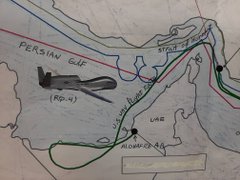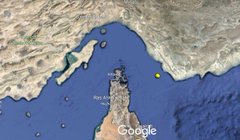By Justin Rohrlich
More than a decade before Iran shot down a US military RQ-4 Global Hawk surveillance drone on June 20, its manufacturer pitched the Department of Defense on expanding the fleet by presenting a hypothetical conflict with the Islamic Republic.
In a 2008 briefing document, Northrop Grumman presented the Pentagon with an analysis of the “future security environment” and how the Global Hawk drone might play a central role. An at-the-time imaginary war with Iran features heavily in the sales pitch.
“Deterring and, if needed, fighting a traditional theater conflict will remain a high priority for [US military commanders],” the report reads. “A hypothetical conflict with Iran in the 2015 to 2020 timeframe will provide a framework for discussion.”
The document was produced by the Northrop Grumman Analysis Center, a self-described in-house “think tank.” Quartz found it hosted in an obscure corner of the company’s website, along with a dozen or so other studies on topics ranging from laser weapons to stealth technology.
The 11-year-old paper also considers other uses for the Global Hawk, including maritime operations and border security. All in, Northrop Grumman recommended the Pentagon purchase 157 of its Global Hawk drones.
There were 42 Global Hawk drones in service as of 2015. The unmanned aerial vehicles (UAVs) cost up to $220 million each, with new requirements and upgrades making them significantly more expensive than the original $15.3 million price tag projected by Northrop Grumman in 1999.

Based on the imagined future conflict with Iran, Northrop Grumman estimated that seven to eight Global Hawks would be necessary to obtain the surveillance coverage needed. In the wider region, the company recommended at least 16 more Global Hawks because “more than one hostile nation is seeking ballistic missile capability with WMD [weapons of mass destruction] and force planning guidance requires anticipating multiple, nearly simultaneous major combat operations.”

Northrop Grumman declined to comment and referred Quartz to the DoD. DoD did not immediately respond to an inquiry.
Little clarity
Tehran said the Global Hawk it downed over the Strait of Hormuz this week had been on a spy mission over Iranian territory. Washington insisted the “unprovoked attack” occurred in international air space.

US CENTRAL COMMAND VIA APThe Global Hawk’s flight path when it was shot down, as described by the US military.
The US wages #EconomicTerrorism on Iran, has conducted covert action against us & now encroaches on our territory.
We don't seek war, but will zealously defend our skies, land & waters.
We'll take this new aggression to #UN & show that the US is lying about international waters
The newly heightened tensions between the two countries began in earnest in 2018, when the US government unilaterally withdrew from the landmark Iran nuclear deal signed in 2015. In that deal, Iran agreed to abandon its pursuit of a nuclear weapon in exchange for the lifting of economic sanctions. The Trump administration has now reinstated and extended those sanctions. While Iran has threatened to again ramp up its efforts to build a nuclear weapon in response, it has so far adhered to the original deal.
The US blames Iran for apparent attacks on commercial oil tankers in the Gulf of Oman. No one was killed in those attacks and Tehran has denied any involvement. It did, however, take full responsibility for shooting down the Global Hawk drone.



No comments:
Post a Comment